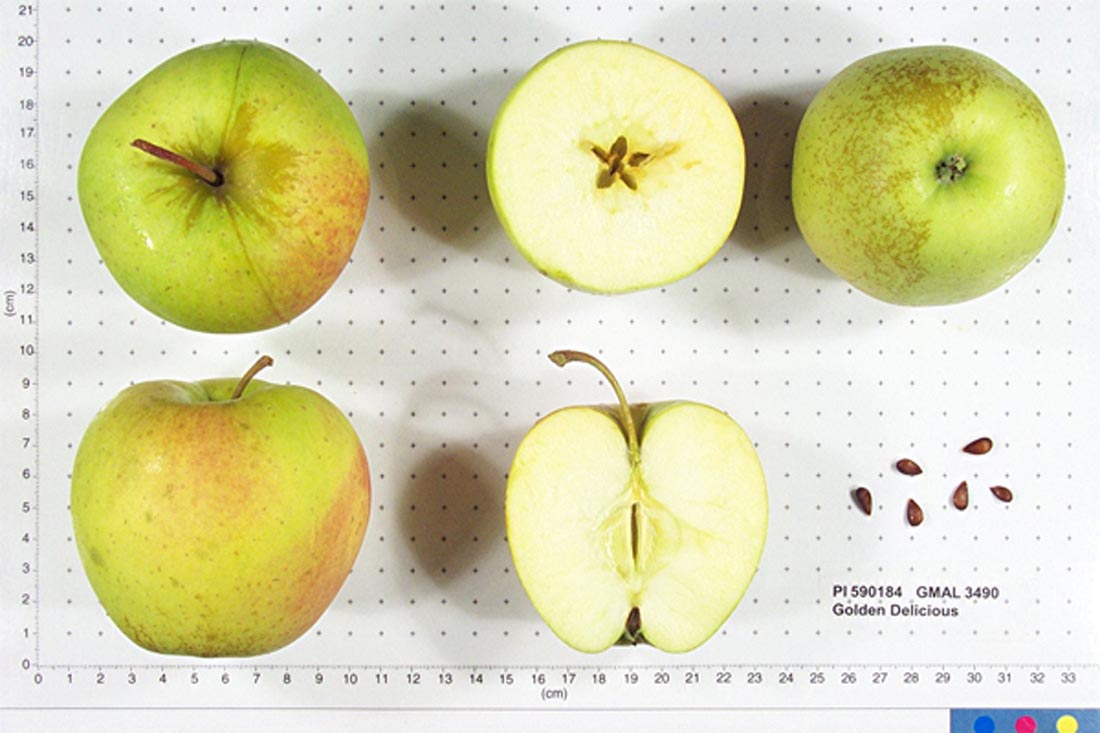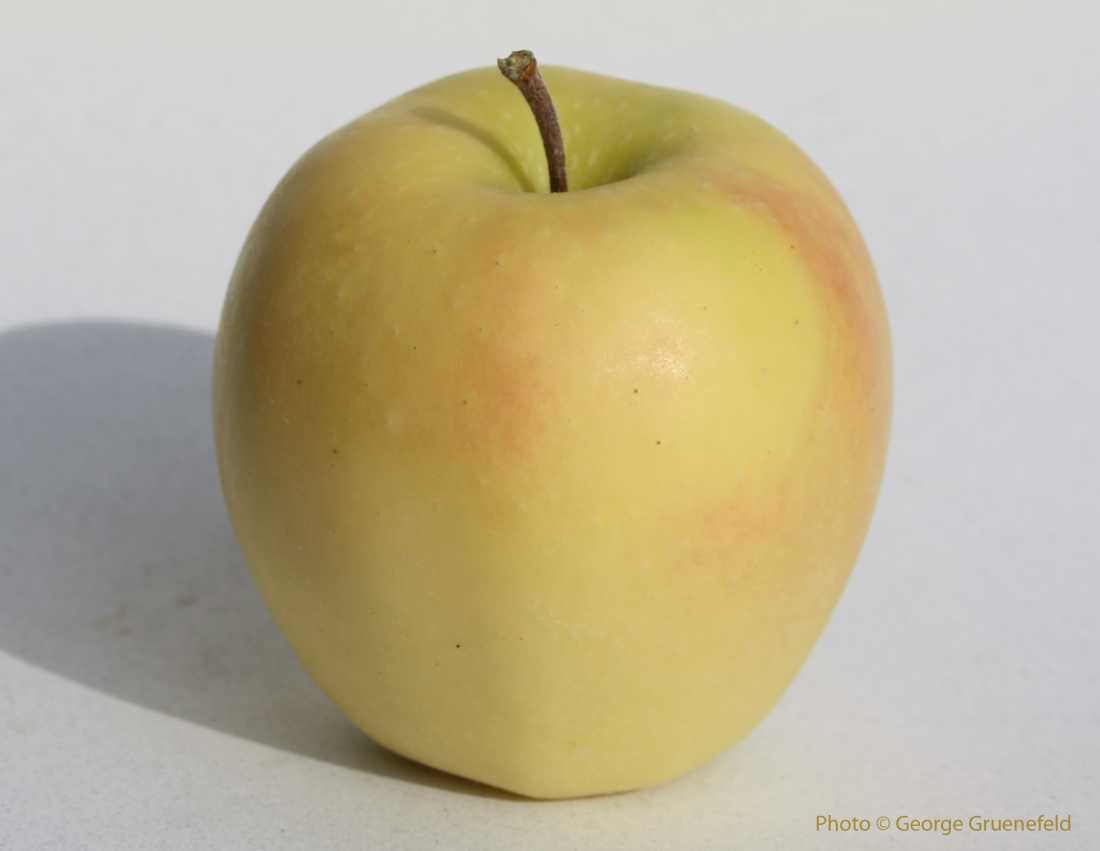Pomiferous
Welcome to the world's most extensive apples (pommes) database.
Information on over 7,000 apples is available here, all carefully researched and provided in a way that is easy to navigate.
Golden Delicious
type: Cider, Dessert, Sauce
synonyms: Initially this apple was referred to as Mullins' Seedling and Mullins' Yellow Seedling ( Mullins' Yellow Seedling ), as well as Annit Apple. After Stark Brothers' Nursery acquired full rights to the apple in 1914, it was renamed Stark's Golden Delicious and later as Golden Delicious. Along the way it was also called Annit apple and Arany Delicious. Fruit and cuttings acquired without permission after 1914 were usually referred to as Yellow Delicious. Also referred to as Early Golden.
summary: A very sweet and somewhat spicy apple found growing wild in the northern panhandle of West Virginia, U.S.A., in the early 1900s. Now one of the best known and most widely bred apple varieties. Note that there is a similar variety -- see Early Golden -- which also emerged on the Mullins farm and is considered a varietal of its own.
identification: Medium large, round conic, sometimes oblong. Often slightly ribbed. Smooth skin, greenish yellow when almost ripe, golden yellow with russet lenticels. The sun-exposed face is blushed with faint red. Dark russeted, small, raised lenticels. The stem is long and slender, set in a deep and moderately wide cavity which may have some russeting.
characteristics: Cream-coloured flesh, tender and crisp. Fragrant. Sweet, juicy, mild honey taste and floral. Slow to brown when cut open.
uses: It seems a shame that one of the finer apples grown today is frequently and widely mistreated on its way to the consumer. In the case of the Golden Delicious, the apple is often picked several weeks before it is ripe, then stuck in cold storage for too long and then placed in supermarket shelves for as long as it takes to sell them. To fully appreciate the Golden, it needs to be picked when ripe and consumed before it ages. U-pick operations and farm gate sales are a good source of Goldens in shape to be fully appreciated.
origins: Encountered in 1891 as a chance seedling by 15-year-old John Mullins while hoeing a field on his father’s farm at Odessa hamlet in Clay County, West Virginia (U.S.A.), likely the progeny of four apple trees -- Grimes Golden ( Grimes Golden ) and (Golden Reinette Golden Reinette ) -- growing near farmhouse. The seedling was left to grow and start producing handsome golden-yellow apples resembling Grimes Golden .
In 1905, Anderson Mullins -- Jack Mullin's uncle -- took over the farm and, in the process, turned his attention to the tree, which had started to produce fruit and, under the name of Mullins Golden Seedlings, had become increasingly popular in the northern panhandle area of West Virginia. In the October of 1914, Anderson Mullins sent a box of three Mullins’ Yellow Seedling apples to Paul Stark Sr. at Stark Brothers Nursery in Michigan for evaluation.
"Dear Sir," Mullins wrote in his accompanying letter. "I am sending you a small box or apples for inspection by mail. They are off a seedling tree in my orchard. The tree is such a nice tree and bears such fine apples. We like them so well that we think them almost as good as Delichous. No one here has anything like it. The apples are so rich they will make apple butter without sugar. Please try them and write and tell me what you think of them. - A.H. Mullins."
Paul Stark did more than write back -- he hustled in excess of 1,000 kilometres by rail, cart and horseback to see for himself. The nursery quickly bought all rights to the tree plus the 900 square-foot plot of land on which the tree stood for $5,000 and marketed it as a companion to its Stark Delicious . Stark Brothers wasted no time in acquiring all rights to the apple and the tree it grew on and, in the course of just a few years promoted the Golden Delicious into one of the best known apples in the western world and the second-most eaten apple in the world.
cultivation: Moderately vigorous, round spreading tree that tolerates late frosts. Bears fruit on spurs and terminal branches. Starts to bear when young and produces heavy crops, but needs to be thinned aggressively after fruit set to ensure annual harvests, otherwise tends to become biennial. There is a tendency to develop russet skin in humid growing conditions.
cold storage: Keeps up to five months in cold storage.
vulnerabilities: Somewhat susceptible to fireblight. Susceptible to scab and rust. Resistant to mildew. Somewhat prone to canker. Bitter pit can be a problem. Slightly susceptible to brown rot.
harvest: Fully ripe after the middle of the fifth period (140 to 160 days after petal fall).
notes: It was designated the official state fruit of West Virginia in 1955.
pollination group: D
pollination peak: 12
ploidism: Self fertile, but the crop improves in the presence of a compatible source of pollen.
cold storage weeks: 20
brix: 13.1
acidity: 5.5
harvest period: 5
flowers: White
hardiness: 5
Donate a cider?
©2016-2021 Pomiferous.com. All rights reserved

